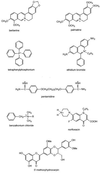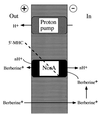Synergy in a medicinal plant: antimicrobial action of berberine potentiated by 5'-methoxyhydnocarpin, a multidrug pump inhibitor
- PMID: 10677479
- PMCID: PMC26451
- DOI: 10.1073/pnas.030540597
Synergy in a medicinal plant: antimicrobial action of berberine potentiated by 5'-methoxyhydnocarpin, a multidrug pump inhibitor
Abstract
Multidrug resistance pumps (MDRs) protect microbial cells from both synthetic and natural antimicrobials. Amphipathic cations are preferred substrates of MDRs. Berberine alkaloids, which are cationic antimicrobials produced by a variety of plants, are readily extruded by MDRs. Several Berberis medicinal plants producing berberine were found also to synthesize an inhibitor of the NorA MDR pump of a human pathogen Staphylococcus aureus. The inhibitor was identified as 5'-methoxyhydnocarpin (5'-MHC), previously reported as a minor component of chaulmoogra oil, a traditional therapy for leprosy. 5'-MHC is an amphipathic weak acid and is distinctly different from the cationic substrates of NorA. 5'-MHC had no antimicrobial activity alone but strongly potentiated the action of berberine and other NorA substrates against S. aureus. MDR-dependent efflux of ethidium bromide and berberine from S. aureus cells was completely inhibited by 5'-MHC. The level of accumulation of berberine in the cells was increased strongly in the presence of 5'-MHC, indicating that this plant compound effectively disabled the bacterial resistance mechanism against the berberine antimicrobial.
Figures




Similar articles
-
In search of natural substrates and inhibitors of MDR pumps.J Mol Microbiol Biotechnol. 2001 Apr;3(2):247-54. J Mol Microbiol Biotechnol. 2001. PMID: 11321580 Review.
-
Berberis aetnensis C. Presl. extracts: antimicrobial properties and interaction with ciprofloxacin.Int J Antimicrob Agents. 2003 Jul;22(1):48-53. doi: 10.1016/s0924-8579(03)00085-2. Int J Antimicrob Agents. 2003. PMID: 12842327
-
Berberine-INF55 (5-nitro-2-phenylindole) hybrid antimicrobials: effects of varying the relative orientation of the berberine and INF55 components.Antimicrob Agents Chemother. 2010 Aug;54(8):3219-24. doi: 10.1128/AAC.01715-09. Epub 2010 May 24. Antimicrob Agents Chemother. 2010. PMID: 20498327 Free PMC article.
-
5'-Methoxyhydnocarpin-D and pheophorbide A: Berberis species components that potentiate berberine growth inhibition of resistant Staphylococcus aureus.J Nat Prod. 2000 Aug;63(8):1146-9. doi: 10.1021/np990639k. J Nat Prod. 2000. PMID: 10978214
-
An Update on Staphylococcus aureus NorA Efflux Pump Inhibitors.Curr Top Med Chem. 2020;20(24):2168-2185. doi: 10.2174/1568026620666200704135837. Curr Top Med Chem. 2020. PMID: 32621719 Review.
Cited by
-
Sophisticated natural products as antibiotics.Nature. 2024 Aug;632(8023):39-49. doi: 10.1038/s41586-024-07530-w. Epub 2024 Jul 31. Nature. 2024. PMID: 39085542 Review.
-
Synthesis of organic-inorganic hybrid nanocomposites modified by catalase-like catalytic sites for the controlling of kiwifruit bacterial canker.RSC Adv. 2024 May 31;14(25):17571-17582. doi: 10.1039/d4ra02006e. eCollection 2024 May 28. RSC Adv. 2024. PMID: 38828279 Free PMC article.
-
Plant antibacterials: The challenges and opportunities.Heliyon. 2024 May 11;10(10):e31145. doi: 10.1016/j.heliyon.2024.e31145. eCollection 2024 May 30. Heliyon. 2024. PMID: 38803958 Free PMC article. Review.
-
Designing combinational herbal drugs based on target space analysis.BMC Complement Med Ther. 2024 May 1;24(Suppl 1):179. doi: 10.1186/s12906-024-04455-9. BMC Complement Med Ther. 2024. PMID: 38693521 Free PMC article.
-
Computational mechanistic investigation of the kinetic resolution of α-methyl-phenylacetaldehyde by norcoclaurine synthase.Commun Chem. 2024 Mar 27;7(1):64. doi: 10.1038/s42004-024-01146-x. Commun Chem. 2024. PMID: 38538750 Free PMC article.
References
-
- Levy S B. Sci Am. 1998;278:46–53. - PubMed
-
- Lewis K. In: Transport of Molecules Across Microbial Membranes. Broome-Smith J K, Baumberg S, Stirling C J, Ward F B, editors. Vol. 58. Cambridge, U.K.: Cambridge Univ. Press; 1999. pp. 15–40.
-
- Nikaido H. Curr Opin Microbiol. 1998;1:516–523. - PubMed
-
- Lolkema J S, Poolman B, Konings W N. Curr Opin Microbiol. 1998;1:248–253. - PubMed
Publication types
MeSH terms
Substances
LinkOut - more resources
Full Text Sources
Other Literature Sources
Medical
Research Materials


